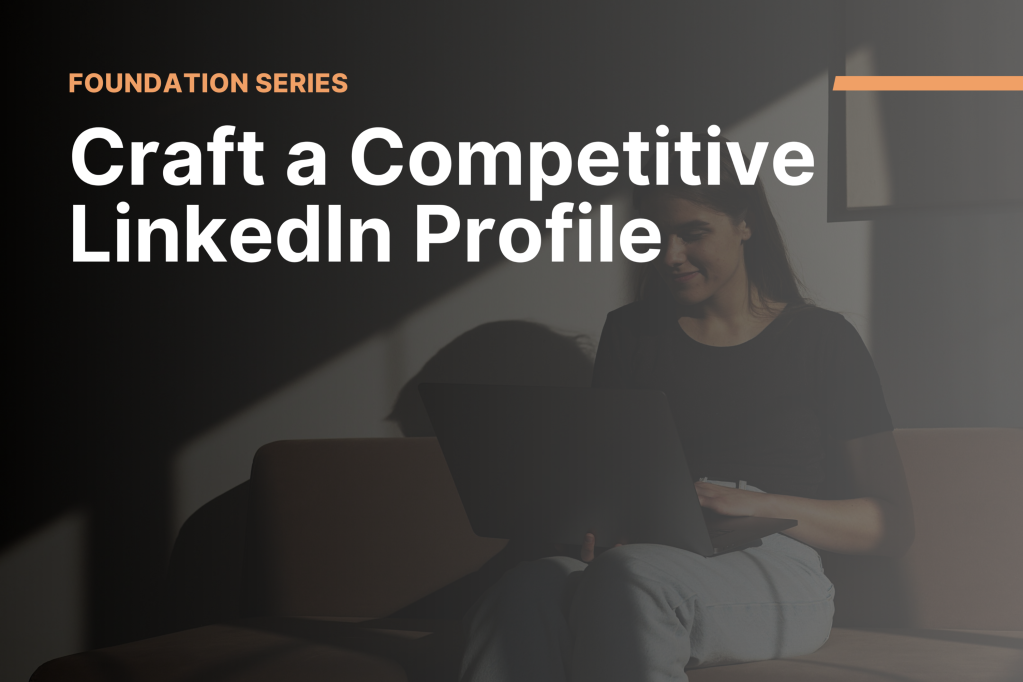
About LinkedIn
Why is your LinkedIn Profile Important?
Pay as much attention to your LinkedIn profile as you do to your resume and other materials. A strong LinkedIn profile will lead to more positive responses when you ask to meet with people and will also help companies trying to differentiate between applicants. Recruiters often use LinkedIn to find qualified candidates, so the more robust your profile, the more likely recruiters will find you.
Your LinkedIn profile will use much of the same information as you included in your resume, so no need to start from scratch. Keep your resume or CV handy as you develop your LinkedIn profile.
Industry-Backed LinkedIn
An industry-backed LinkedIn profile reflects your personal brand, demonstrates your accomplishments, and showcases your interests. It offers an online presence that speaks to your professional values, and it helps facilitate more efficient networking.
Use the following criteria to develop your LinkedIn profile. Your Career Team will use the same criteria when providing feedback.
LinkedIn Profile Criteria
Compelling introductory information.
- Professional profile photo.
- Customized background image.
- Up to date contact information (email).
- Catchy headline that incorporates your target role.
- Clear summary statement that speaks to your experience, background, and professional qualifications.
Clear experience and education section.
- Experience listed in reverse chronological order with job title, job description, company name, city and state/province, and dates of employment.
- Experience section includes accomplishments – not just job duties.
- Education section in reverse chronological order and includes your program listed.
- Ensure on your end that both sections align with the content included in your resume or CV.
Skills, recommendations, accomplishments and interests sections provide a fuller picture of who you are.
- At least 20 skills, both technical and transferable.
- At least 2-4 recommendations that attest to your skill set and work ethic.
- At least 2-3 projects highlighted, with working links.
- At least 20 interests displayed, with a mix of personal and professional interests.
No spelling or grammar errors.
- All spelling is accurate with consistent punctuation.
- Tone consistent throughout.
- All links are working.
Note: You can customize your LinkedIn URL. In the upper-right corner of your profile, you’ll see and can click “Edit public profile and URL.” This is your chance to personalize your URL, which will make you easier to find through Google or Bing.
LinkedIn Guide
Get started with the steps below!
Step 1: Set Up Your Basic Information.
- Profile Photo: Your profile photo is a representation of your brand as a professional. You should be smiling and wearing business casual clothing in the picture. You may choose to get a professional headshot, or you may already have a good picture. This picture should be used across all platforms, so that companies who are looking to learn more about you recognize you.
- Background Image: On LinkedIn, you can replace the LinkedIn template background with a background of your own. This photo should be between 1000×425 and 4000×4000 pixels, and you can google “LinkedIn background images” for some options. Select a background image that is in line with your personal brand. This photo should be consistent with your portfolio color schemes.
- Contact Information: Include up-to-date contact information that allows recruiters and connections to contact you. Use a professional email address (e.g. not hotmail) and make sure you include phone numbers and email addresses that you check on a regular basis.
- Headline: Write a catchy headline that highlights your background and encourages employers to review your profile. Include positive qualities and highlight your uniqueness in the headline. Here are some examples:
- Experienced Cybersecurity professional with expertise in securing websites from internal and external threats.
- Full stack web developer with a passion for turning ideas into results.
- Multidisciplinary designer focused on Visual, UI, and UX design.
- Technology Project Manager focused on agile methodologies and scrum frameworks.
- Summary: Your summary should be based on your professional brand statement. Just as you did for your resume, take that statement, and adapt it for LinkedIn. You may want to add a bit more of your “voice” for your LinkedIn summary than you did for your resume as this summary provides a more detailed story of you and your life/career progression.
Step 2: Convey Your Experience and Education.
- Experience: The experience section should present your employment in an easy-to-follow way. Employers should be able to clearly follow your employment history (including places and dates, job titles, and skills). The titles, dates, and locations should mirror your resume precisely. If you had to cut important content from your resume or CV to save space, you could add in this section on LinkedIn.
- Education: Your education should first list the university programs you have successfully completed and then the degrees you have received in reverse chronological order. Your program certificate or degree should be listed first. To add a certificate to the section, click the plus icon. In ‘School’, list the university, in ‘Degree’, write “Certificate” and in ‘Field of Study’, list the name of your program. Again, this section should mirror your resume or CV.
Step 3: Add Skills, Recommendations, Accomplishments and Interests.
Skills and Endorsements: Employers want to see both technical and transferable skills. Include soft skills that you have used in previous jobs (e.g. time management, organization, problem solving). You should have at least 20 skills. Maintaining a targeted list of skills on your profile helps you gain interest from potential employers and match you with the right opportunities.
How to add and remove skills from the “Skills and Endorsements” section:
- Click the “Me” icon at the top of your LinkedIn homepage.
- Click “View Profile.”
- Scroll down to the “Featured Skills and Endorsements” section and click “Edit.”
- Click and drag the four lines corresponding to the skill to re-order them.
- Click “Save” on your Edit Profile page.
Recommendations
Employers understand your skills better when they can read positive feedback from previous supervisors, coworkers, professors, etc. Recommendations should attest to your skill set and work ethic, adding valuable information to your profile. Request recommendations from 2-4 (or more) of your connections. You can do that by going to the profile of your potential recommender, at the top, select More > Request Recommendation. This button sends a LinkedIn message and email to that user, and is often a more productive way to get the recommendation written than a verbal request as it sends the writer to the exact place they need to go.
Accomplishments
Highlight your top 2-3 projects in this section, making sure the most recent accomplishments are at the top (you can click and drag if they are out of order).
Include a description, the languages/tool/strategies/methods or case tests used, and a direct link to the result, prototypes or code.
Interests
A strong interests section can help employers feel connected to you. List interests that demonstrate your active involvement in the industry and professional-related groups, companies, and other entities, and follow companies and/or people within your industry space. Have a minimum of 20 interests, and make sure they are varied. Choose concepts, ideas, influencers, sports teams, schools, companies, etc.
Step 4: Proofread.
At this point, go back and proofread your LinkedIn profile.
- Make sure spelling is accurate.
- Check for consistent punctuation.
- Check to make sure the tone is consistent throughout.
- Check to make sure any links are working.
- Ask a friend or family member to review as well.









